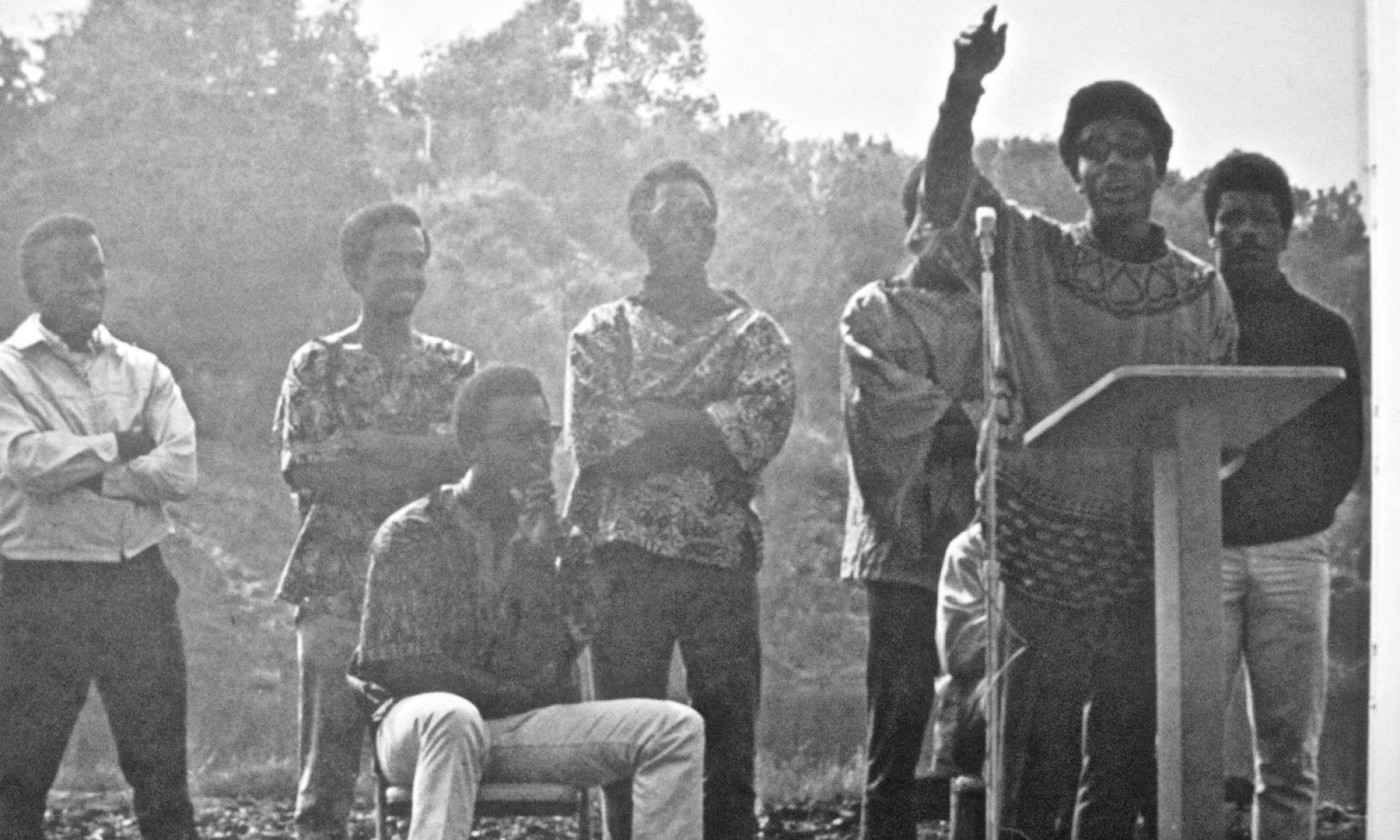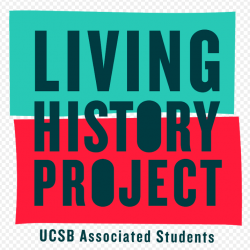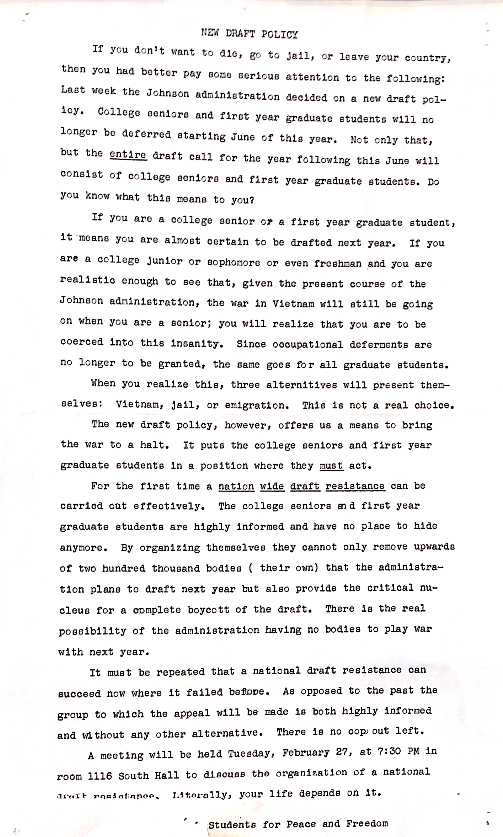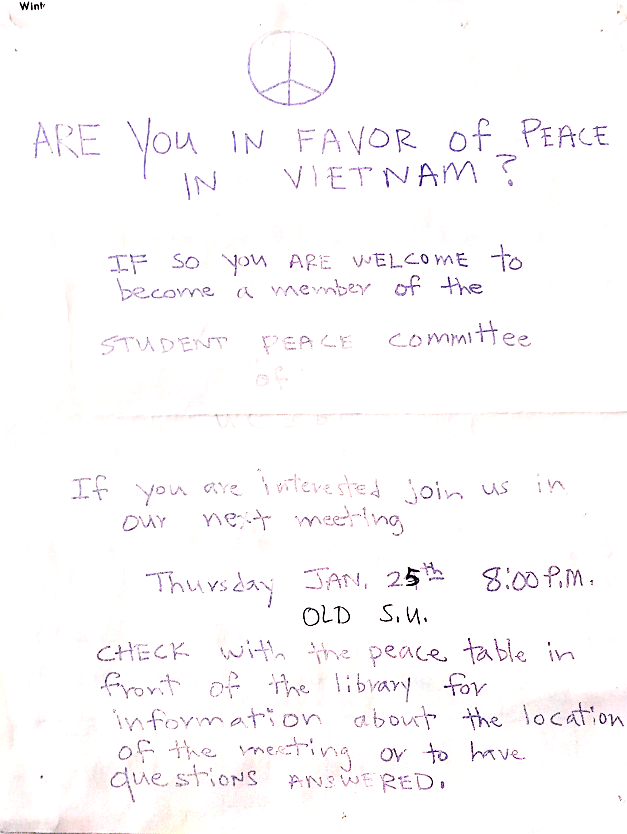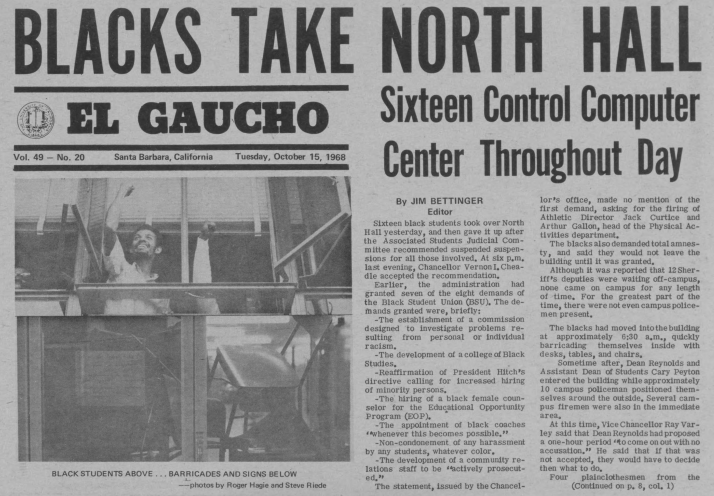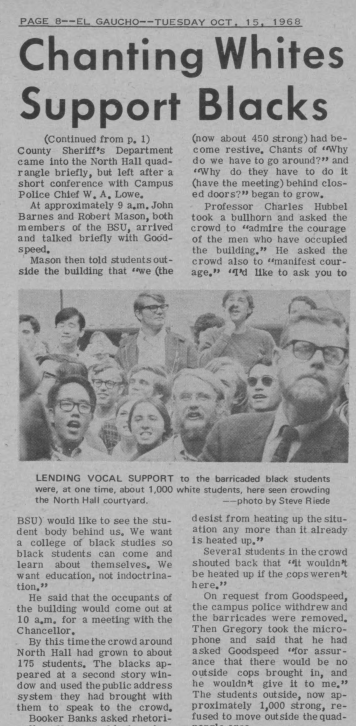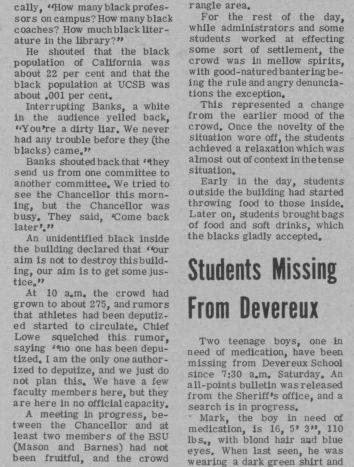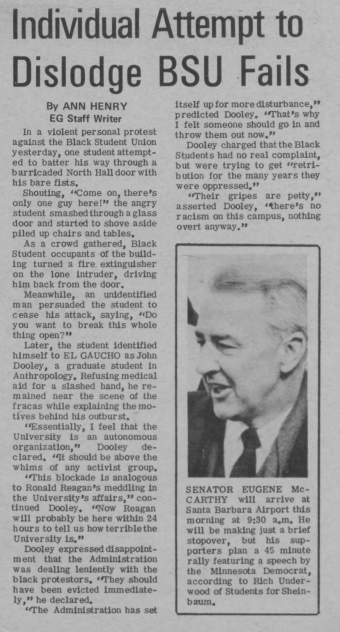By Sophia Chupein
May 1965
College students played an indispensable role in the anti-Vietnam war movement during the 1970s, and UCSB was no exception. Beginning in May of 1965, students protested and discussed the war in every way imaginable. Students participated through draft resistance, engaging in faculty discussions, attending teach-ins, and joining organizations such as the Student Peace Committee (see below). A large part of the UCSB student body, however, did not view these forums as adequate measures to protest the Johnson administration’s foreign policy measures. Student protests, both peaceful and violent, erupted across America as the U.S Army continually invaded and bombed Southeast Asia beginning in 1965. The validity of the UCSB Reserve Officers’ Training Corps (ROTC) was being brought into question during this time as well, since many students believed its actions should be more accommodating to protestors. UCSB students expressed their vehement anger towards U.S foreign policy through a series of violent protests in 1967, causing thousands of dollars worth of property damage in Isla Vista and the temporary shutdown of the Santa Barbara Airport. These protests sent an unfiltered message to the U.S Government: that they would be held accountable for their decisions, no matter what the cost.
[(“New Draft Policy”, University of California, Santa Barbara, Student Organizations Collection, Box 4). University of California, Santa Barbara, Associated Students Records. UArch 101. Department of Special Collections, UC Santa Barbara Library, University of California, Santa Barbara.]
[(“Are You in Favor of Peace in Vietnam”, University of California, Santa Barbara, Student Organizations Collection, Box 4). University of California, Santa Barbara, Associated Students Records. UArch 101. Department of Special Collections, UC Santa Barbara Library, University of California, Santa Barbara.]
[(“University Committee on War and Peace”, University of California, Santa Barbara, Student Organizations Collection, Box 10). University of California, Santa Barbara, Associated Students Records. UArch 101. Department of Special Collections, UC Santa Barbara Library, University of California, Santa Barbara.]
Protests, marches, and calls to action were ubiquitous around campus. These took the form of movie showings, theater productions, lectures, speeches, and artwork. Here are some of the many postings reminding students of the urgency of protest and circumstances of the war:
 [(Matson, R. 1971, November 3). “The Time to Act is Now.” Daily Nexus, Retrieved from https://www.alexandria.ucsb.edu/downloads/t148fj11g]
[(Matson, R. 1971, November 3). “The Time to Act is Now.” Daily Nexus, Retrieved from https://www.alexandria.ucsb.edu/downloads/t148fj11g]
 [(Okamura/OPS 1972, April 19). Daily Nexus, Retrieved from https://www.alexandria.ucsb.edu/downloads/3x816n74p]
[(Okamura/OPS 1972, April 19). Daily Nexus, Retrieved from https://www.alexandria.ucsb.edu/downloads/3x816n74p]
 [(Levine, D 1973, May 11). Daily Nexus, Retrieved from https://www.alexandria.ucsb.edu/downloads/rj4305584]
[(Levine, D 1973, May 11). Daily Nexus, Retrieved from https://www.alexandria.ucsb.edu/downloads/rj4305584]
 [(1967, October 20). “Scoreboard” El Gaucho, Retrieved from https://www.alexandria.ucsb.edu/downloads/bk128b88g]
[(1967, October 20). “Scoreboard” El Gaucho, Retrieved from https://www.alexandria.ucsb.edu/downloads/bk128b88g]
In October of 1965, Students for Free Political Action (SFPA) sponsored the first teach-ins, movie screenings, and speeches from nationally recognized activists at UCSB. October also marked the first of many rallies in opposition to the war, which in turn sparked the first student conflicts regarding the morality of America’s involvement in Vietnam. For instance, the previously inactive Young Americans for Freedom group mobilized in 1965 in order to protest SFPA actions on campus.
 [(Winograd, B. 1965, October 15). “Viet Nam protest today; vigil stirs counter-pickets” El Gaucho, https://www.alexandria.ucsb.edu/downloads/h128nf83m]
[(Winograd, B. 1965, October 15). “Viet Nam protest today; vigil stirs counter-pickets” El Gaucho, https://www.alexandria.ucsb.edu/downloads/h128nf83m]
Joan Baez, a widely known folk songwriter and activist, came to UCSB in October of 1966 to speak in David Arnold’s Sociology 128 class about the war in Vietnam, non-violence, and taking political action. Joan Baez was a part of the outspoken liberal minority that had been speaking out against U.S. involvement in Vietnam since the beginning of the conflict.
 [(Shelton, J. 1966, October 20). “Joan Baez describes Non Violence School” El Gaucho, Retrieved from https://www.alexandria.ucsb.edu/downloads/mp48sd947]
[(Shelton, J. 1966, October 20). “Joan Baez describes Non Violence School” El Gaucho, Retrieved from https://www.alexandria.ucsb.edu/downloads/mp48sd947]
 [(Shelton, J. 1966, October 20). “Non-Violent revolt asked by pacifist” El Gaucho, Retrieved from https://www.alexandria.ucsb.edu/downloads/mp48sd947]
[(Shelton, J. 1966, October 20). “Non-Violent revolt asked by pacifist” El Gaucho, Retrieved from https://www.alexandria.ucsb.edu/downloads/mp48sd947]
Though Baez’s non-violent rhetoric resonated with many UCSB students, frustration with the war and the rise of organized student activism in the 1960s mobilized thousands of UCSB students. 1967 was filled with both peaceful and violent student protests. One of the primary debates within the UCSB student body was regarding the rights of the ROTC. The ROTC was voluntarily established at UCSB shortly after World War II and provided a way for male students during this period to fulfill their military obligations. When student protestors began attacking the ROTC during the height of the war, many students defended the military program, claiming that ROTC officers were facing injustice and stereotyping. Major Bailey told the Daily Nexus in 1967 that the ROTC faculty members would “jump at the chance to discuss the issues with anyone willing to take the time…Pacifist attacks such as those witnessed here recently do not help matters any” (1971, November 3) Daily Nexus.
 [(1968, October 17) El Gaucho, Retrieved from https://www.alexandria.ucsb.edu/downloads/bg257g27q]
[(1968, October 17) El Gaucho, Retrieved from https://www.alexandria.ucsb.edu/downloads/bg257g27q]
During Fall Quarter of 1967, The Daily Nexus and El Gaucho were covered with letters to the editor about how the ROTC should handle student activism, and whether or not the ROTC should be considered for academic credit. It was during this period that widespread disillusionment with the war began reaching the general American public. The televised atrocities of the war and the exponentially rising cost to taxpayers were becoming increasingly evident. The Student Peace Committee was a prominent voice in the ROTC debate.
 [(Samuelsen, M. 1967, October 3). “Peace Committee ROTC Clash on ‘Academic’ Debate” El Gaucho, Retrieved from https://www.alexandria.ucsb.edu/downloads/tq57ns101]
[(Samuelsen, M. 1967, October 3). “Peace Committee ROTC Clash on ‘Academic’ Debate” El Gaucho, Retrieved from https://www.alexandria.ucsb.edu/downloads/tq57ns101]
Perspectives on the ROTC debate took on many forms. Many students viewed protests against the military institution as unjust and unsubstantiated. While most of these opinions were made public through the Daily Nexus, a group of students and Santa Barbara citizens formed an organization called “Friends of the ROTC”, which defended the military group’s role on campus (see below).
 [(Hankins, J. 1971, November 3). “‘Friends of ROTC’ Formed by Santa Barbara Citizens” El Gaucho, Retrieved from https://www.alexandria.ucsb.edu/downloads/ww72bc81w]
[(Hankins, J. 1971, November 3). “‘Friends of ROTC’ Formed by Santa Barbara Citizens” El Gaucho, Retrieved from https://www.alexandria.ucsb.edu/downloads/ww72bc81w]
 [(Russ, B. 1967, October 18). “A Defence of ROTC” El Gaucho, Retrieved from https://www.alexandria.ucsb.edu/downloads/r494vm27z]
[(Russ, B. 1967, October 18). “A Defence of ROTC” El Gaucho, Retrieved from https://www.alexandria.ucsb.edu/downloads/r494vm27z]
 [(Russ, B. 1967, October 18). “A Defence of ROTC” El Gaucho, Retrieved from https://www.alexandria.ucsb.edu/downloads/r494vm27z]
[(Russ, B. 1967, October 18). “A Defence of ROTC” El Gaucho, Retrieved from https://www.alexandria.ucsb.edu/downloads/r494vm27z]
 [(Krend, J. 1967, October 31). “ROTC Dispute Rages on” El Gaucho, Retrieved from https://www.alexandria.ucsb.edu/downloads/9s161716b]
[(Krend, J. 1967, October 31). “ROTC Dispute Rages on” El Gaucho, Retrieved from https://www.alexandria.ucsb.edu/downloads/9s161716b]
Each escalation of U.S involvement in the war brought with it a new wave of student protest. When the Nixon administration approved the U.S invasion of Cambodia in 1970, rising anti-war sentiments coalesced into an unprecedented national student strike. The magnitude of this strike delivered an ultimatum to the U.S government, warning that if the U.S extends the invasion in Southeast Asia, turmoil will ensue on the home front.
 [(“The U.S. Military has Invaded Cambodia”, University of California, Santa Barbara, Student Organizations Collection, Box 10). University of California, Santa Barbara, Associated Students Records. UArch 101. Department of Special Collections, UC Santa Barbara Library, University of California, Santa Barbara.]
[(“The U.S. Military has Invaded Cambodia”, University of California, Santa Barbara, Student Organizations Collection, Box 10). University of California, Santa Barbara, Associated Students Records. UArch 101. Department of Special Collections, UC Santa Barbara Library, University of California, Santa Barbara.]
When Nixon and National Security Advisor Henry Kissinger further escalated the war through implementing Operation Linebacker in 1972, UCSB students grew furious. The day after the bombing of Hanoi and Haiphong, students shut down the Santa Barbara airport, resulting in the cancellation of all flights for that day. The violence of these riots resulted in one person falling from a three-story building, while 13 others were arrested.
 [(Rimer, S; Haight, A. 1972, May 10). “2,500 shut down S.B. airport” Daily Nexus, Retrieved from https://www.alexandria.ucsb.edu/downloads/mp48sd972]
[(Rimer, S; Haight, A. 1972, May 10). “2,500 shut down S.B. airport” Daily Nexus, Retrieved from https://www.alexandria.ucsb.edu/downloads/mp48sd972]
When police forces tried to subdue the protest at 9:30 pm, students began yelling “freeway!”, and headed to Hollister Avenue and Highway 101. By 10:00 pm, when students realized a fence stood between them and the highway, they began walking back to IV, telling police officers they wanted no confrontation. A police car then sped directly towards the back of the marching group and swerved off the road, injuring and arresting protestors. As police officers continued to drive through the crowds, one woman parked on Hollister told the Daily Nexus “Well they must have been [beating protestors], didn’t you hear the screaming?”. At 10:35 pm, a bonfire was set off in Perfect Park, and protestors began marching through IV to gain members for a march on the ROTC. When the group was confronted by the ROTC, a protestor drove his car directly into the line of ROTC members. As rocks were being thrown back and forth, the ROTC threw a total of five canisters of tear gas into the crowd on Pardall. By 2:00 am the demonstrators had dispersed (Rimer, S. 1972, May 11. Daily Nexus).
 [(Cline, V. 1972, May 10). “Night actions rock Isla Vista” Daily Nexus, Retrieved from https://www.alexandria.ucsb.edu/downloads/mp48sd972]
[(Cline, V. 1972, May 10). “Night actions rock Isla Vista” Daily Nexus, Retrieved from https://www.alexandria.ucsb.edu/downloads/mp48sd972]
 [(Eber, R.1972, May 11). “Riot damage in Tuesday action at approximately $6,000” Daily Nexus, Retrieved from https://www.alexandria.ucsb.edu/downloads/g445cf259]
[(Eber, R.1972, May 11). “Riot damage in Tuesday action at approximately $6,000” Daily Nexus, Retrieved from https://www.alexandria.ucsb.edu/downloads/g445cf259]
This event angered many students who felt that these violent protests were unjustified, as demonstrated by this letter to the editor of the Daily Nexus:
 [(Randall, T. 1972, May 10). “Letter to the Editor” Daily Nexus, Retrieved from https://www.alexandria.ucsb.edu/downloads/mp48sd972]
[(Randall, T. 1972, May 10). “Letter to the Editor” Daily Nexus, Retrieved from https://www.alexandria.ucsb.edu/downloads/mp48sd972]
The following day, 1,000 UCSB students gathered on the UCen lawn to continue the anti-war rally. They marched throughout campus and into Oglesby’s History of California class in Campbell Hall, gathering more and more students as they went. Before the Isla Vista rally later that day, about 250 students confronted 25 ROTC officers at the ROTC building. “One officer was hit by a can and knocked down…two students climbed on top of the building, and 10 students were eventually allowed to enter the building to speak with Army Officers” (Daily Nexus, May 10 1972).
On May 11th, the following day, Ronald Reagan walked off his helicopter onto Santa Barbara grounds, where he was greeted by 1,000 demonstrators. While 1,200 members of Santa Barbara’s social elite dined with Reagan, the demonstrators (mostly from UCSB) sang and chanted outside. No confrontational or violent incidents occurred.
The events that occurred during these years at UCSB reflected the anger, disappointment, and frustration of students with the U.S government’s decisions. The debates, teach-ins, rallies, and protests that took place on campus are testaments to the abilities of young people to enact meaningful change. The Santa Barbara airport protestors received national news coverage from NBC and CBS, mirroring the American public’s growing opposition to the Vietnam war. Additionally, reactions to the anti-war protests demonstrated the wide range of political opinions that have always been present on the UCSB campus, and how social unrest can facilitate meaningful debate.
